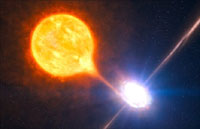 A small black hole has been observed blowing a vast bubble of hot gas 1,000 light-years across.
A small black hole has been observed blowing a vast bubble of hot gas 1,000 light-years across.
The gas is expanding because it is being heated by powerful particle "jets" being released by the black hole.
The observations were made by the Very Large Telescope in
Astronomers have unveiled the findings in the latest edition of Nature journal.
A small black hole has been observed blowing a vast bubble of hot gas 1,000 light-years across.
The gas is expanding because it is being heated by powerful particle "jets" being released by the black hole.
The observations were made by the Very Large Telescope in
 Astronomers have unveiled the findings in the latest edition of Nature journal.
Astronomers have unveiled the findings in the latest edition of Nature journal.
"We have been astonished by how much energy is injected into the gas by the black hole," says lead author Manfred Pakull, from the University of Strasbourg, France.
Black holes are known to release a prodigious amount of energy when they swallow matter.
It was thought that most of this energy was released in the form of radiation, predominantly X-rays.
However, the new findings show that some black holes can spew out at least as much energy, perhaps more, as "jets" of fast-moving particles.
Astronomers say the two streams of particles they observed are the most powerful pair of jets ever seen from a stellar-mass black hole.
"The length of the jets in NGC 7793 is amazing, compared with the size of the black hole from which they are launched," said co-author Robert Soria, from the Mullard Space Science Laboratory at University College London (UCL).
"If the black hole were shrunk to the size of a soccer ball, each jet would extend from the Earth to beyond the orbit of Pluto."
The black hole, located in the spiral galaxy NGC 7793, some 12 million light-years away, is thought to be only a few times the mass of our Sun.
That makes it a minnow compared with the giant black holes which usually reside at the centres of galaxies.

 Previous page
Previous page Back to top
Back to top







